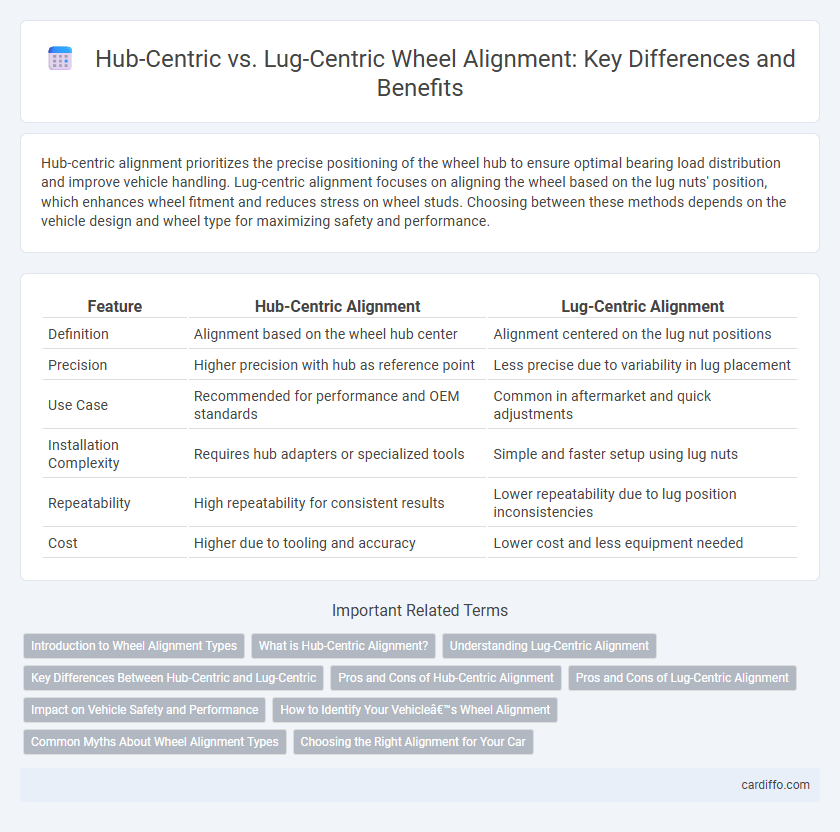Hub-centric alignment prioritizes the precise positioning of the wheel hub to ensure optimal bearing load distribution and improve vehicle handling. Lug-centric alignment focuses on aligning the wheel based on the lug nuts' position, which enhances wheel fitment and reduces stress on wheel studs. Choosing between these methods depends on the vehicle design and wheel type for maximizing safety and performance.
Table of Comparison
| Feature | Hub-Centric Alignment | Lug-Centric Alignment |
|---|---|---|
| Definition | Alignment based on the wheel hub center | Alignment centered on the lug nut positions |
| Precision | Higher precision with hub as reference point | Less precise due to variability in lug placement |
| Use Case | Recommended for performance and OEM standards | Common in aftermarket and quick adjustments |
| Installation Complexity | Requires hub adapters or specialized tools | Simple and faster setup using lug nuts |
| Repeatability | High repeatability for consistent results | Lower repeatability due to lug position inconsistencies |
| Cost | Higher due to tooling and accuracy | Lower cost and less equipment needed |
Introduction to Wheel Alignment Types
Hub-centric alignment centers the wheel using the hub bore, ensuring precise alignment and optimal load distribution, which enhances tire wear and vehicle stability. Lug-centric alignment relies on lug nuts to center the wheel, which may introduce slight misalignment due to wheel runout but is more common in everyday repairs. Understanding the distinction between these two alignment types is crucial for accurate wheel positioning, improved handling, and maximizing tire lifespan.
What is Hub-Centric Alignment?
Hub-centric alignment is a wheel alignment method where adjustments are made based on the vehicle's hub or wheel center, ensuring the wheels are positioned perpendicular to the hub axis for optimal handling and tire wear. This technique prioritizes the alignment of suspension geometry relative to the hub, improving steering precision and reducing mechanical stress. Unlike lug-centric alignment, which centers adjustments around the wheel lugs, hub-centric alignment offers enhanced accuracy in maintaining proper wheel angles and vehicle stability.
Understanding Lug-Centric Alignment
Lug-centric alignment centers the wheel hub around the vehicle's lug pattern, ensuring precise positioning and balance critical for optimal torque distribution and vehicle handling. This method reduces the risk of wheel runout and uneven tire wear by focusing on the lug holes as the primary reference point rather than the hub bore. The enhanced accuracy of lug-centric alignment improves overall safety and performance, particularly in high-stress driving conditions.
Key Differences Between Hub-Centric and Lug-Centric
Hub-centric alignment centers the vehicle's wheel directly on the hub flange, ensuring precise rotational balance and reducing stress on wheel studs, which enhances overall stability and handling performance. Lug-centric alignment relies on the wheel being centered by the lug nuts, which can lead to slight misalignment and increased vibration due to the wheel not being perfectly centered on the hub. Key differences include the accuracy of wheel centering--hub-centric offers better precision--and compatibility, as hub-centric designs require matching hub bore sizes, whereas lug-centric wheels depend on lug nut fit for centering.
Pros and Cons of Hub-Centric Alignment
Hub-centric alignment offers precise centering of the wheel hub, resulting in enhanced wheel stability and reduced vibration during driving. This method minimizes uneven tire wear and improves suspension performance by ensuring the hub is perfectly aligned with the axle shaft. However, hub-centric alignment requires specialized equipment and skilled technicians, which can increase service costs and time compared to more straightforward alignment techniques.
Pros and Cons of Lug-Centric Alignment
Lug-centric alignment offers precise positioning by utilizing the lug bolts as reference points, which enhances wheel balance and reduces tire wear. However, it can be less accurate on vehicles with worn or damaged lugs, potentially leading to improper alignment angles. This method is also time-consuming compared to hub-centric alignment, which relies on the hub diameter for quicker, more consistent setups.
Impact on Vehicle Safety and Performance
Hub-centric alignment ensures the wheel is perfectly centered on the hub, reducing vibrations and improving steering precision, which enhances overall vehicle safety and performance. Lug-centric alignment, where the wheel centers on the lug nuts, may introduce slight misalignment causing uneven tire wear and compromised handling. Proper hub-centric alignment minimizes stress on suspension components, contributing to longer vehicle lifespan and safer driving dynamics.
How to Identify Your Vehicle’s Wheel Alignment
Identify your vehicle's wheel alignment by examining tire wear patterns; uneven wear on the inner or outer edges typically indicates camber issues in hub-centric alignment, while uneven wear across the tread suggests problems with lug-centric alignment. Measure the wheel angles using alignment tools to check if the hubs are properly centered on the axle or if the lugs are securely aligned with the wheel hub bolt pattern. Inspecting the wheel hub and lug positioning can help diagnose whether adjustments are needed to correct the camber, toe, or caster angles to optimize vehicle handling and tire longevity.
Common Myths About Wheel Alignment Types
Common myths about wheel alignment types include the belief that hub-centric alignment always provides better vehicle stability compared to lug-centric alignment, which is not universally true as both methods rely on proper installation and the specific vehicle design. Another misconception is that lug-centric alignment causes more vibration, while in reality, vibration can result from improper torque or damaged components regardless of alignment style. Understanding the precise differences and correct application of hub-centric and lug-centric alignment is essential for optimal wheel performance and safety.
Choosing the Right Alignment for Your Car
Choosing the right alignment for your car depends on the vehicle's suspension design and driving conditions. Hub-centric alignment centers the wheel based on the hub's size, providing precise fitment and improved stability, especially for performance vehicles. Lug-centric alignment focuses on the lug nut circle for centering, which is common in aftermarket wheels but may cause slight vibrations if the hub bore and wheel center don't perfectly match.
Hub-Centric Alignment vs Lug-Centric Alignment Infographic

 cardiffo.com
cardiffo.com